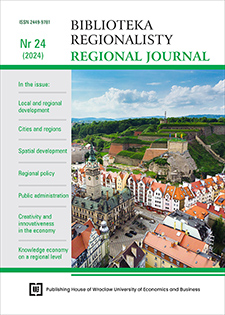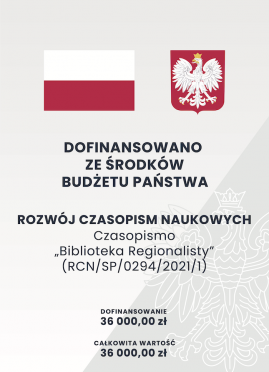Transformacja energetyki odnawialnej w Europie w ciągu ostatnich dwóch dekad
DOI:
https://doi.org/10.15611/br.2024.1.03Słowa kluczowe:
rozwój zrównoważony, OZE, udział energii odnawialnejAbstrakt
Cel: Celem artykułu jest zbadanie ewolucji udziału odnawialnych źródeł energii w wybranych krajach europejskich w okresie od 2005 do 2022 r. Analiza obejmuje kraje o różnym poziomie wdrożenia energii odnawialnej i podkreśla regionalne różnice w jej wzroście.
Metoda: W badaniu wykorzystano analizę ilościową danych energetycznych Eurostatu, aby określić udział odnawialnych źródeł energii w całkowitym końcowym zużyciu energii w krajach europejskich w latach 2005, 2012 i 2022. Statystyki opisowe, porównania i analiza trendów są wspierane przez wizualizacje, w tym mapy, wykresy słupkowe i liniowe, aby ukazać zmiany w czasie.
Rezultaty: Wyniki wskazują na znaczny postęp w zakresie wdrażania odnawialnych źródeł energii w Europie w latach 2005-2022, z wyraźnymi różnicami w tempie wzrostu pomiędzy krajami, co podkreśla zarówno sukcesy, jak i wyzwania związane z transformacją energetyczną.
Implikacje i rekomendacje: Wyniki badania podkreślają potrzebę wprowadzenia ukierunkowanych polityk i mechanizmów wsparcia, aby pomóc krajom, które wolniej wdrażają odnawialne źródła energii, szczególnie w zakresie przezwyciężania barier ekonomicznych i strukturalnych, które mogą utrudniać postęp.
Oryginalność/wartość: Badanie dostarcza kompleksowej analizy wzrostu udziału odnawialnych źródeł energii w Europie w latach 2005-2022, oferując unikalne spojrzenie na regionalne różnice i czynniki wpływające na zróżnicowane tempo wdrażania energii odnawialnej.
Pobrania
Bibliografia
Atici, C. (2009). Carbon emissions in Central and Eastern Europe: environmental Kuznets curve and implications for sustainable development. Sustainable Development, 17(3), 155-160. https://doi.org/10.1002/sd.372
Communication from the Commission to the European Parliament, the European Council, the Council, the European Economic and Social Committee and the Committee of the Regions The European Green Deal. (COM(2019) 640 final, 11.12.2019). https://eur-lex.europa.eu/legal-content/EN/TXT/?uri=CELEX:52019DC0640
Dizdaroglu, D. (2019). Measuring residential sustainability performance: An indexing approach. International Journal of Sustainable Development, 22(1-2), 1-23. https://doi.org/10.1504/IJSD.2019.104717
European Commission/Eurostat. (2019). Sustainable development in the European Union: Monitoring report on progress towards the SDGs in an EU context: 2019 edition. Publications Office. https://data.europa.eu/doi/10.2785/44964
Eurostat. (n.d.). Database. Retrieved August 21, 2024, from https://ec.europa.eu/eurostat/data/database
Fischer, J., Helman, K., Kramulová, J., Petkovová, L., & Zeman, J. (2013). Sustainable development indicators at the regional level in the Czech Republic. Statistika, 93(1), 5-19.
Herrmann, M. (2014). The challenge of sustainable development and the imperative of green and inclusive economic growth. Modern Economy, 5(2), 113-119. https://doi.org/10.4236/me.2014.52013
Hlaváček, P., Skalník, V. (2021). The implementation of smart energy into transformation of the rural area: The use of public policies for smart villages development. International Journal of Energy Economics and Policy, 11(4), 1-6. https://doi.org/10.32479/ijeep.11203
Joseph, C., Gunawan, J., Madi, N., Janggu, T., Rahmat, M., & Mohamed, N. (2019). Realising sustainable development goals via online integrity framework disclosure: Evidence from Malaysian and Indonesian local authorities. Journal of Cleaner Production, 215, 112-122. https://doi.org/10.1016/J.JCLEPRO.2019.01.057
Lazaretti, K., Giotto, O. T., Sehnem, S., & Bencke, F. F. (2019). Building sustainability and innovation in organizations. Benchmarking. An International Journal, 27(7), 2166-2188. https://doi.org/10.1108/BIJ-08-2018-0254
Manolis, E. N., & Manoli, E. N. (2021). Raising awareness of the Sustainable Development Goals through Ecological Projects in Higher Education. Journal of Cleaner Production, 279, Article 123614. https://doi.org/10.1016/j.jclepro.2020.123614
Megyesiova, S., & Lieskovska, V. (2018). Analysis of the sustainable development indicators in the OECD countries. Sustainability, 10(12), Article 4554. https://doi.org/10.3390/su10124554
Pilewicz, T., & Derlukiewicz, N., Mempel-Śnieżyk. A., & Zdon-Korzeniowska, M. (2018). Entrepreneurial activity, market orientation, investment attractiveness and transaction costs for enterprises in local development context. Barometr
Regionalny. Regional Barometer, 16(3), 109-119. https://doi.org/10.56583/br.356
Regulation (EU) 2021/1119 of the European Parliament and of the Council of 30 June 2021 establishing the framework for achieving climate neutrality and amending Regulations (EC) No 401/2009 and (EU) 2018/1999 (‘European Climate Law’) (Official Journal of the European Union, L 243, 9.7.2021, 1–17). https://eur-lex.europa.eu/eli/reg/2021/1119/oj/eng
Robert, K. W., Parris, T. M., & Leiserowitz, A. A. (2005). What is sustainable development? Goals, indicators, values, and practice. Environment: Science and Policy for Sustainable Development. 47(3), 8-21. https://doi.org/10.1080/00139157.2005.10524444
Rusak, H. (2009). Energetyka odnawialna w świetle wskaźników zrównoważonego rozwoju systemów energetycznych . Prace Naukowe Uniwersytetu Ekonomicznego we Wrocławiu, (83), 31-39.
World Bank. (2012.) Inclusive green growth: The pathway to sustainable development. Washington, DC. http://hdl.handle.net/10986/6058
Pobrania
Opublikowane
Numer
Dział
Licencja
Prawa autorskie (c) 2025 Anna Mempel-Śnieżyk

Utwór dostępny jest na licencji Creative Commons Uznanie autorstwa – Na tych samych warunkach 4.0 Miedzynarodowe.
Accepted 2025-01-14
Published 2025-01-31







